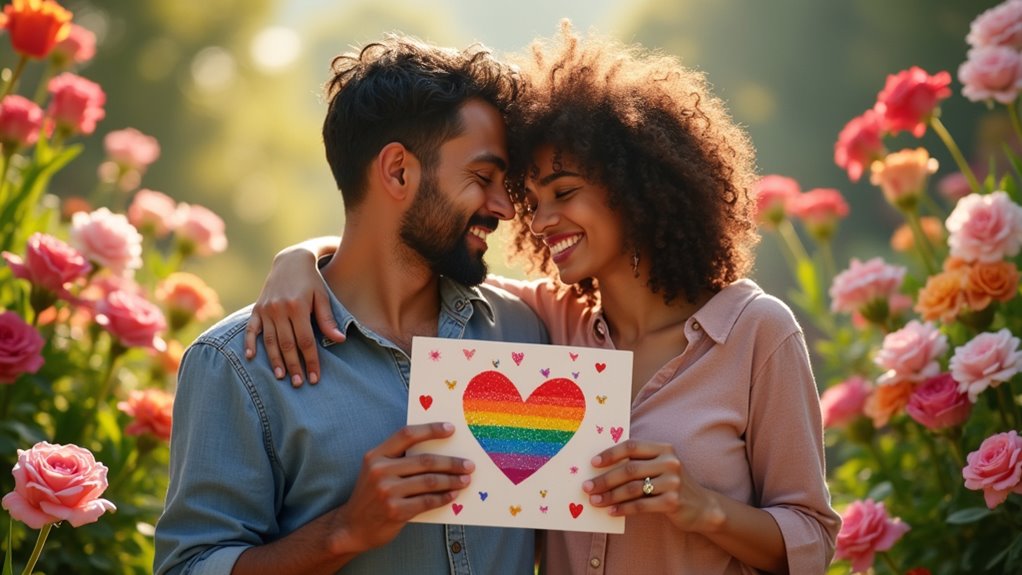Did you know that over 75% of LGBTQ+ individuals feel that inclusive language makes a difference in how they’re perceived? As Valentine’s Day approaches, it’s an opportunity to show genuine support and appreciation through thoughtful messages that honor diverse identities. But crafting such greetings can be tricky—how do you express love and respect without unintentionally excluding or misrepresenting someone? Exploring inclusive ways to celebrate love might just transform how you connect this season.
Key Takeaways
- Use gender-neutral language and affirming titles like “partner” or “loved one” to respect diverse identities.
- Incorporate symbols and colors from pride flags to symbolize love, pride, and solidarity in greetings.
- Personalize messages with specific gestures, compliments, and thoughtful details reflecting the unique bond.
- Highlight the meaning behind pride flags and symbols to deepen appreciation and understanding of LGBTQ+ history.
- Foster respectful communication by asking for pronouns and creating a safe space to celebrate love and identity.
Celebrating Love Beyond Labels

Have you ever wondered why love can’t be simply celebrated for what it is, rather than how it’s labeled? Love transcends labels when you focus on romantic poetry and shared experiences that highlight genuine connection. Instead of emphasizing categories, you can honor the feelings that unite you through heartfelt messages and meaningful moments. Think about the memories you’ve created together—the quiet mornings, laughter, and support—that define your relationship more than any label ever could. Celebrate love for its pure essence by emphasizing your unique bond. This approach allows you to express affection without boundaries, making every greeting a genuine reflection of your relationship. Additionally, understanding the impact of advocacy and education can deepen your appreciation for diverse expressions of love and identity. Ultimately, love is about connection, not classification.
Crafting Personal and Inclusive Messages
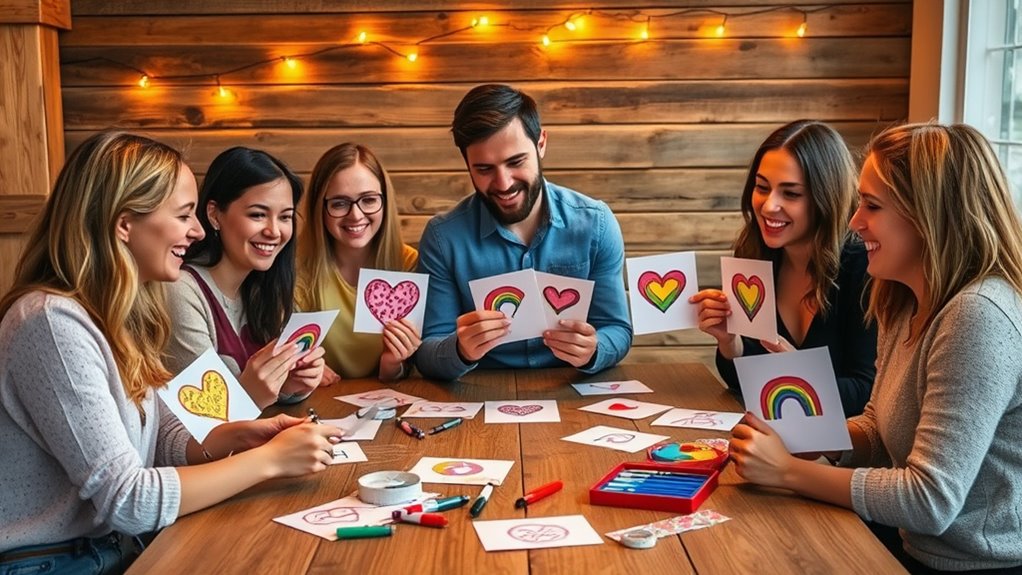
Wondering how to create heartfelt Valentine messages that feel truly inclusive? Focus on personal touches that celebrate your unique bond. Start by mentioning specific romantic gestures that resonated with both of you, making your message deeply personal. Next, incorporate thoughtful compliments that highlight their qualities and your appreciation. Finally, consider the presentation—beautiful gift wrapping can add a special touch, showing effort and care. To make your message even more inclusive, avoid assumptions about gender or gender roles, and instead, speak from the heart. Use language that emphasizes love, respect, and connection. Remember, a sincere message paired with a thoughtful gift can make your partner feel truly seen and appreciated this Valentine’s Day. Incorporating themes of water park amenities can also add a fun and playful element to your celebration if you’re planning a special getaway.
Using Gender-Neutral Language in Your Greetings

To create truly inclusive Valentine greetings, it’s essential to use gender-neutral language that respects and celebrates all identities. Incorporate gender neutral pronouns like “they/them” or avoid pronouns altogether to make your message more inclusive. Using inclusive language tips, such as replacing “boyfriend” or “girlfriend” with “partner” or “loved one,” ensures your greeting feels welcoming to everyone. Be mindful of assumptions about gender or relationship labels, and choose words that affirm diverse identities. Simple adjustments like these show you value inclusivity and respect. Additionally, understanding the importance of candle symbolism can enhance your expressions of love and appreciation. Remember, the goal is to communicate affection without excluding or alienating anyone. By consciously using gender-neutral language, you create heartfelt, respectful greetings that truly celebrate love in all its forms.
Expressing Affection for Different Types of Relationships
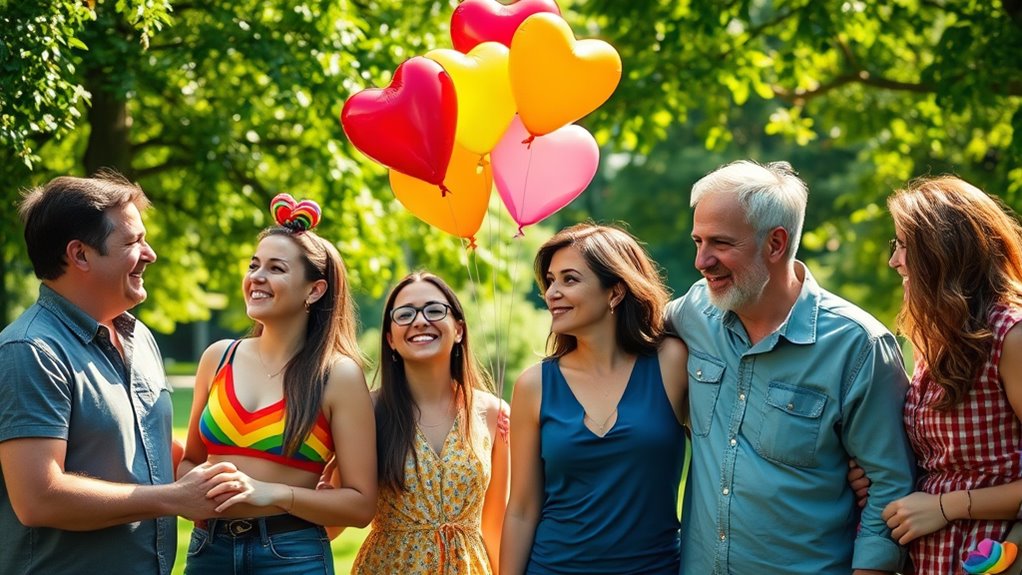
When expressing affection, it’s important to celebrate diverse love styles and find words that reflect each relationship’s unique nature. Using inclusive language helps you honor all connections, whether they’re romantic, platonic, or somewhere in between. Embracing different relationship expressions makes your greetings more meaningful and authentic. Being mindful of affiliate disclosure and privacy policies ensures your messages respect everyone’s boundaries and preferences.
Celebrating Diverse Love Styles
Celebrating diverse love styles means recognizing and honoring the many ways people express affection and build connections. Each relationship is unique, with its own romantic rituals and love languages that deepen bonds. To embrace this diversity, consider these approaches: 1. Customize romantic rituals that resonate with your partner’s love language, whether it’s cooking together, shared hobbies, or thoughtful gestures. 2. Communicate openly about each other’s love languages, so you can express affection in ways that truly resonate. 3. Celebrate the variety of relationship structures by acknowledging the love and commitment that define each connection, regardless of societal expectations. Additionally, understanding the trustworthiness of brands involved in your self-care routines can enhance your overall well-being and confidence in your relationship.
Inclusive Language Choices
Choosing inclusive language when expressing affection helps guarantee everyone feels seen and respected. Instead of relying on gender-specific language or traditional expressions like “husband” or “wife,” opt for neutral terms such as “partner,” “beloved,” or “loved one.” This approach honors all relationship types, whether same-sex, polyamorous, or otherwise non-traditional. Be mindful of language that may unintentionally exclude or alienate, and replace it with words that celebrate diversity. For example, instead of “my bride,” say “my partner” or “my love.” Using inclusive language fosters a warm, welcoming tone and ensures your Valentine greetings resonate with everyone, regardless of their relationship structure or gender identity. Additionally, practicing mindful language choices can improve communication and promote a more inclusive environment for all.
Unique Relationship Expressions
Expressing affection in a way that reflects your relationship’s uniqueness can make your Valentine greetings more meaningful. Whether you’re celebrating with a romantic poetry recital or simple affectionate gestures, tailoring your expressions shows deep appreciation for your bond. Consider these ideas:
- Write a personalized poem that captures your feelings and shared experiences, blending romantic poetry with your own words.
- Use affectionate gestures, like a surprise hug or holding hands, to convey love beyond words.
- Create a custom message or card that highlights your relationship’s special qualities, making your greeting stand out.
- Incorporate elements of bedroom decor or ambiance to make your romantic gestures feel even more intimate and cozy.
Incorporating Symbols and Colors That Represent Lgbtq+ Pride
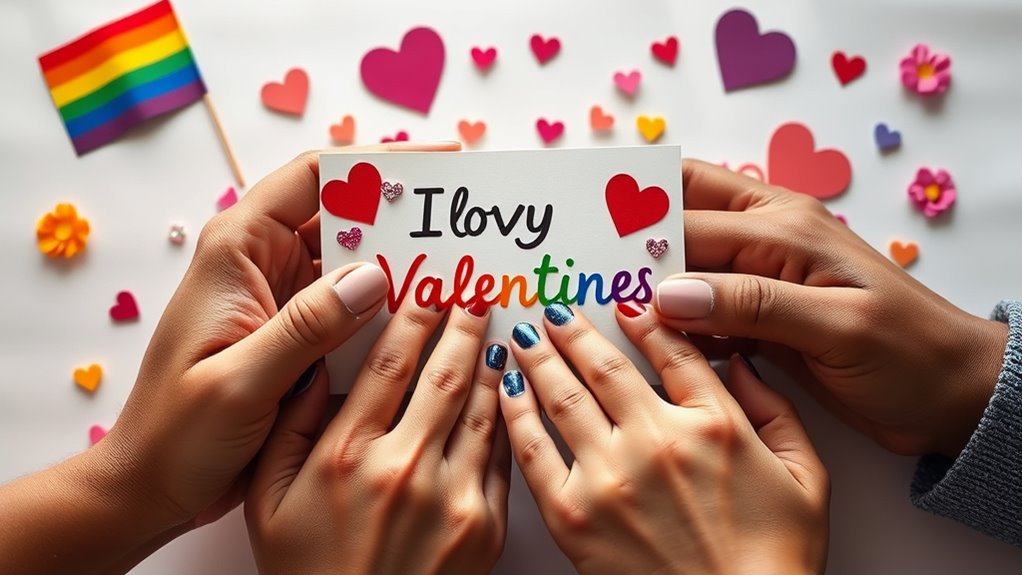
You can celebrate LGBTQ+ pride by including symbols like rainbow flags or other pride flags that resonate with specific identities. Understanding the meaning behind each color helps you choose the right symbols to express your support and love. Get creative by incorporating these symbols into your greetings, gifts, or decorations to make your message more meaningful. Recognizing the importance of emotional expression can help strengthen your connection and foster a safe space for sharing feelings.
Symbolic Pride Flags
Symbolic pride flags use specific colors and symbols to represent different aspects of LGBTQ+ identities and communities. These flags embody rainbow symbolism, which highlights diversity and inclusion. The pride flag history reveals how each addition reflects unique identities and causes within the movement. When you see a pride flag, you’re witnessing a visual story of community and history. Here are three key points:
- The original rainbow flag, created in 1978, symbolizes unity and diversity within LGBTQ+ communities.
- Variations like the bisexual, transgender, and pansexual flags incorporate distinct symbols and colors to communicate specific identities.
- These flags serve as powerful symbols of pride, solidarity, and ongoing struggles for equal rights.
Understanding these flags helps you appreciate their significance beyond mere decoration, honoring the history and symbolism behind each design. Additionally, recognizing flag symbolism fosters greater respect and awareness of the diverse identities within the LGBTQ+ community.
Meaning Behind Colors
The colors and symbols woven into pride flags carry deep meaning, conveying more than just visual appeal. Each hue holds meaningful symbolism, representing diverse identities and experiences within the LGBTQ+ community. Understanding color significance helps you appreciate the depth behind these flags and the messages they send. For example, the rainbow flag’s colors stand for life, healing, sunlight, nature, serenity, and spirit. Here’s a quick overview:
| Color | Meaning | Symbolic Representation |
|---|---|---|
| Red | Life | Vitality and passion |
| Orange | Healing | Wellness and strength |
| Yellow | Sunlight | Happiness and energy |
This symbolism fosters unity, pride, and a deeper connection to the community’s diverse identities. Recognizing the spiritual energy behind these symbols can deepen your appreciation for the community’s resilience and connection to universal energies.
Incorporating Symbols Creatively
Incorporating symbols creatively into your Valentine greetings allows you to celebrate LGBTQ+ pride in meaningful and personalized ways. You can enhance your message by using visual symbols, colors, and shared experiences. Consider these ideas:
- Include rainbow-colored accents in your romantic poetry or handwritten notes to symbolize diversity and unity.
- Create a shared playlist featuring songs that incorporate pride symbols or themes, making your celebration more intimate.
- Use pride flags or symbolic emojis within your digital greetings to visually express support and love.
These creative touches show your awareness and respect for LGBTQ+ pride, making your Valentine’s message more heartfelt. By thoughtfully integrating symbols and colors, you turn simple greetings into powerful affirmations of love and acceptance.
Creative Ways to Show Support and Appreciation

Finding creative ways to show support and appreciation can make your gestures feel more meaningful and memorable. You can draw inspiration from cultural traditions and historical influences that celebrate diversity and love. For example, incorporating symbols or customs from LGBTQ+ history, like rainbow flags or Pride parades, adds depth to your expressions of support. Hosting a themed event honoring significant milestones or milestones in LGBTQ+ rights shows your commitment. Handcrafting personalized gifts that reflect shared values or inside jokes also demonstrates thoughtfulness. Sharing stories of historical figures who fought for equality can inspire meaningful conversations. These gestures, rooted in understanding cultural and historical contexts, help you connect more deeply and show genuine appreciation for your partner or friends.
Respectful and Thoughtful Ways to Address Your Partner or Friend
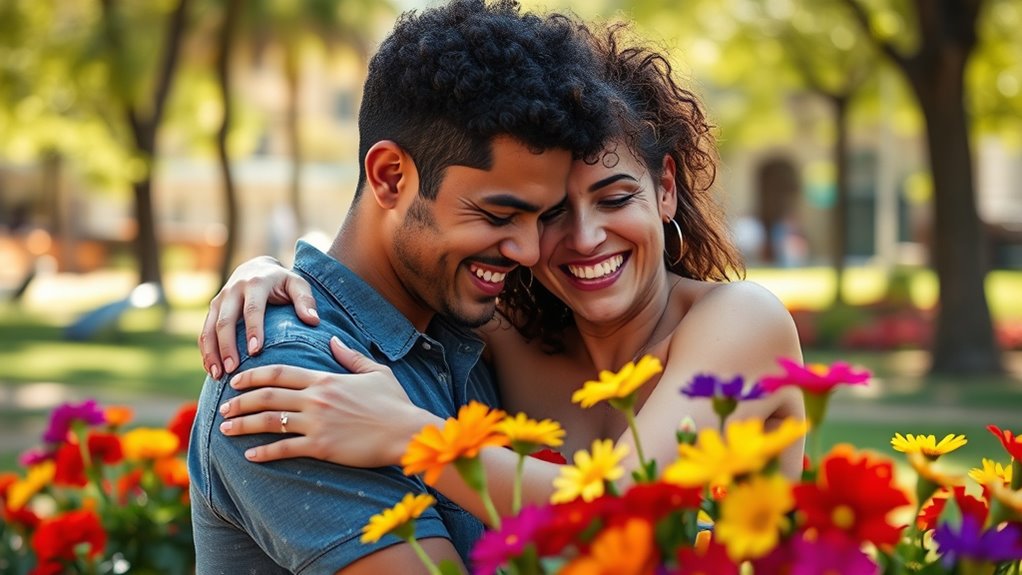
Choosing respectful and thoughtful ways to address your partner or friend shows you value their identity and feelings. To do this, focus on pronoun etiquette and respectful titles. Here are three ways to help you show your respect:
- Ask and use correct pronouns—don’t assume; listen carefully and follow their lead.
- Use respectful titles like “partner,” “friend,” or preferred terms that affirm their identity.
- Incorporate their chosen name consistently, especially in public or formal settings.
Unique Gift Ideas That Celebrate Diversity and Love

Celebrating diversity and love through thoughtful gifts can make your expression of support and affection truly meaningful. When choosing gifts, consider gender neutral gift ideas that highlight inclusivity and personal connection. Items like personalized jewelry, expressive artwork, or thoughtful books celebrating LGBTQ+ stories reflect your appreciation for diversity. To enhance your gesture, incorporate diversity celebration tips such as choosing items that resonate with your partner’s identity or interests. Avoid stereotypes by opting for versatile, meaningful presents that don’t conform to traditional gender roles. These thoughtful choices show your commitment to honoring their individuality and the wider spectrum of love. Ultimately, your gift becomes a symbol of support, acceptance, and celebration of the beautiful diversity that makes each relationship unique.
Frequently Asked Questions
How Can I Ensure My Greeting Is Truly Inclusive and Respectful?
To guarantee your greeting is truly inclusive and respectful, focus on using gender-neutral language, avoiding assumptions about gender or relationship roles. Be mindful of cultural sensitivity by choosing words that honor diverse identities and backgrounds. Consider personal preferences and avoid stereotypes. When in doubt, opt for neutral, heartfelt expressions that celebrate love and connection universally. This approach shows your respect and thoughtfulness, making everyone feel valued and appreciated.
What Are Some Common Mistakes to Avoid in Lgbtq+ Valentine Messages?
Imagine sending a message that unintentionally alienates someone you care about—it’s a risk worth avoiding. To do this, steer clear of common mistakes like using stereotypes or assuming gender roles. Instead, focus on using gender-neutral language and personal, genuine sentiments. By being thoughtful and respectful, you show your true support. Remember, the key is to celebrate love authentically, without assumptions or clichés that could undermine your heartfelt message.
How Do I Navigate Expressing Affection in Non-Traditional Relationship Dynamics?
When expressing affection in non-traditional relationship dynamics, you should prioritize respecting emotional boundaries and consider public expression carefully. Be honest about what feels right for both of you, and communicate openly to avoid misunderstandings. Remember, each relationship is unique; what works for one might not work for another. Always show support and understanding, ensuring your gestures reflect genuine care without crossing personal or societal boundaries.
Are There Specific Symbols or Colors I Should Avoid or Include?
When choosing symbols or colors, consider cultural sensitivities and historical symbolism to avoid missteps. For example, avoid colors or icons that might have negative connotations in certain cultures. Incorporate universally positive symbols like rainbows, which represent diversity and inclusion, but always research their significance. By being mindful of these factors, you show respect and thoughtfulness, creating a meaningful and considerate expression of affection that honors everyone’s identities.
How Can I Personalize Greetings for Partners With Different Gender Identities?
You can personalize greetings by using gender neutral language, avoiding assumptions about their gender identity. Incorporate personalized expressions that reflect your partner’s preferences and personality, making your message more meaningful. Ask about their preferred pronouns and include them in your greeting. Focus on shared experiences and qualities you admire to create a heartfelt message that celebrates your unique bond, showing your genuine care and respect.
Conclusion
This Valentine’s Day, remember that genuine love and support come from honoring each person’s unique journey. For example, imagine writing a heartfelt card for a close friend, acknowledging their identity and shared experiences. Small gestures like this foster connection and inclusivity. By embracing diversity and choosing thoughtful words, you create moments that truly celebrate love in all its beautiful forms. Your kindness can make someone feel seen, valued, and deeply loved.
